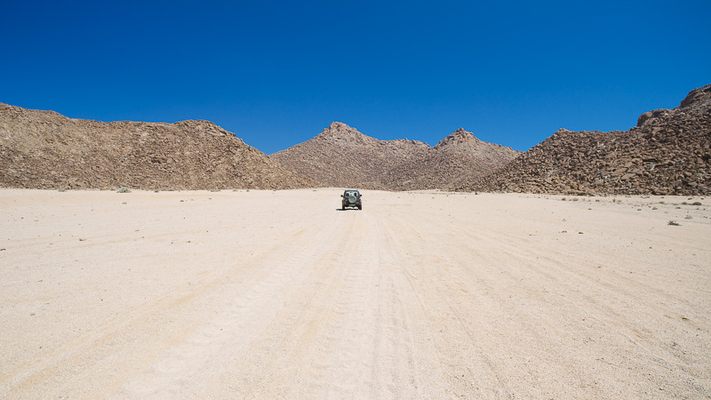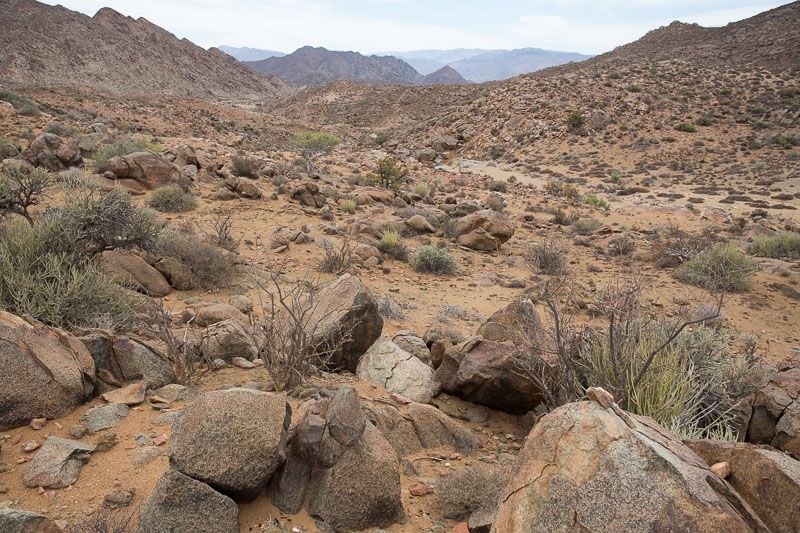About
This remote mountain desert park straddles two countries, earning it two different names: It is Ai-Ais in Namibia and Richtersveld in South Africa. The two regions are divided by the Orange River, well known for diamond mining along its shores, and the Fish River, which feeds into Fish River Canyon, the largest gorge in the world after the Grand Canyon.
Life in the park seems impossible: The inhospitable terrain of steep mountains and sandy plains receives very little rain; temperatures in summer can rise above 122◦F and drop to freezing during winter nights. But it exists. To the keen-eyed observer, animal life abounds in the desert park. Ranging from large antelopes like the gemsbok to smaller mammals like vervet monkeys and clawless otters in the rivers, they are well-adapted to life in this harsh environment.
There are traces of ancient human activity, too. Stone tools and rock paintings dating back 4,000 years have been found in the park. These were the ancestors of the Bushmen (San) and later the Khoikhoi (ancestors to the contemporary Nama-speaking people in the area) that brought the first livestock with them. Today the descendants of these first human occupants are actively involved in the conservancy of the Ai-Ais–Richtersveld Transfrontier Park, which helps keep awareness of their culture alive.
The geology of the park is complex, consisting of many successive geologic events starting with the outflow of lava two billion years ago that formed the oldest rocks in the park today. Upon first entering the park from the Sendelingsdrift Gate, the visitor is greeted by almost otherworldly appearing mountains of various colours and dark bands wedged in between—the result of successive new intrusions of magma between layers of older rock.
As the landscape changes from one panoramic scene to the next, a whitish layer of rock called Tillite can often be seen. On closer inspection fine rocks of different origins are present—evidence of long-disappeared glaciers at work in a region that is now a desert.
The Ai-Ais–Richtersveld Transfrontier Park falls within the Succulent Karoo Biome. Many odd, unique species of plants, especially succulents occur here and nowhere else on earth, adapted specifically to the arid climate. The well-known but extremely rare "Halfmens" (literally meaning "half-human") is an up to 5-metre tall endemic succulent that earned its name because it looks like a human being from a distance. Also typical to the greater region is the Quiver tree, a soft-barked tree of the aloe family that can grow for centuries. Its name originates from the fact that the San people used its hollowed-out trunk as an an arrow quiver.
The African fish eagle can often be seen and heard along the river, which itself plays habitat to large populations of fish and amphibians. Insects and arachnids also abound in the park, and although most are harmless and beneficial to the ecosystem, there are also several dangerously toxic species such as the Black Button spider and the thick-tailed scorpion species. Both the flora and fauna of the region thrive off the "malmokkies," the thick morning fog which rolls in off the Atlantic.
Related Tags
Know Before You Go
The South African part of the Ai-Ais–Richtersveld Transfrontier Park can only be accessed from the Sendelingsdrift Gate (overnight chalets are available) on the western side of the park after travelling up the western coast on the N7 via Alexander Bay from Cape Town. Allow extra travel time when exploring this portion of the park. A four-wheel drive vehicle with spare tyre, tools and drinking water if staying at one of the camps are required.
It is possible to cross the border directly into Namibia to explore the Namibian side of the park by means of a river ferry/pont at Sendelingsdrift.
The Namibian side of the park generally has gravel roads suited to sedan-type vehicles and most accommodation is located in proximity to the Fish River Canyon along the C37 at Ai-Ais hot springs, Hobas campsite or the more upmarket Canyon Roadhouse. This area is accessed most easily from the Namibia/South Africa border near the town of Vioolsdrift.
Community Contributors
Added By
Published
December 9, 2016
Sources
- Ai-Ais -Richtersveld Transfrontier Park - South African National Parks Official Information Guide - Thirde Edition: 2013
- http://www.namibian.org/travel/namibia/ai-ais-richtersveld.html
- https://www.sanparks.org/parks/richtersveld/
- http://www.peaceparks.org/tfca.php?pid=27&mid=1001
- http://www.southafrica.net/za/en/articles/entry/article-southafrica.net-ai-ais-richtersveld-transfrontier-park1








































